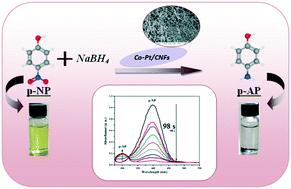当前位置:
X-MOL 学术
›
React. Chem. Eng.
›
论文详情
Our official English website, www.x-mol.net, welcomes your feedback! (Note: you will need to create a separate account there.)
Synthesis of bimetallic Co–Pt/cellulose nanocomposites for catalytic reduction of p-nitrophenol
Reaction Chemistry & Engineering ( IF 3.9 ) Pub Date : 2021-12-14 , DOI: 10.1039/d1re00422k Vividha K. Landge 1 , Vikas S. Hakke 1 , Manohar Kakunuri 1 , G. Uday B. Babu 1 , Grzegorz Boczkaj 2 , Shirish H. Sonawane 1, 2
Reaction Chemistry & Engineering ( IF 3.9 ) Pub Date : 2021-12-14 , DOI: 10.1039/d1re00422k Vividha K. Landge 1 , Vikas S. Hakke 1 , Manohar Kakunuri 1 , G. Uday B. Babu 1 , Grzegorz Boczkaj 2 , Shirish H. Sonawane 1, 2
Affiliation

|
In this study, bimetallic nanoparticles (NPs) of Co–Pt anchored on cellulose nanofibers (CNFs) for catalytic applications were synthesized via a sonochemical approach. The electro-spinning technique was employed for the synthesis of CNFs from cellulose acetate. The thorough characterization of synthesised Co–Pt/CNF nanocomposites was performed with the help of scanning electron microscopy (SEM), Fourier transform infra-red (FT-IR) spectroscopy, field emission scanning electron microscopy (FESEM) with energy dispersive X-ray analysis (EDX), and X-ray diffraction (XRD). This method leads to the facile preparation of Co–Pt bimetallic NPs using cellulose as a support. The synthesized nanocomposites were used for the p-nitrophenol (p-NP) reduction to p-aminophenol (p-AP) with excess sodium borohydride (NaBH4) to assess their catalytic performance. The effects of various parameters on the performance of the catalyst were also investigated. The investigated parameters are catalyst loading, initial p-NP concentration and NaBH4 concentration. The extent of p-NP reduction into p-AP over Co–Pt/CNF nanocomposites with an excess of NaBH4 was examined with UV-vis spectroscopy. The p-NP reduction to p-AP over Co–Pt NPs anchored on CNFs was achieved within 98 seconds with around 100% conversion. The efficiency of the catalyst did not vary significantly up to 5 consecutive cycles. The excellent catalytic activity (Kapp = 0.028 s−1) and stability of the as-synthesized Co–Pt nanoparticles supported on CNFs make them potential catalysts for nitrophenol reduction and wastewater treatment.
中文翻译:

用于催化还原对硝基苯酚的双金属 Co-Pt/纤维素纳米复合材料的合成
在这项研究中,通过声化学方法合成了锚定在纤维素纳米纤维 (CNFs) 上用于催化应用的 Co-Pt 双金属纳米粒子 (NPs) 。静电纺丝技术用于从醋酸纤维素合成 CNF。在扫描电子显微镜 (SEM)、傅里叶变换红外 (FT-IR) 光谱、场发射扫描电子显微镜 (FESEM) 和能量色散 X 射线的帮助下,对合成的 Co-Pt/CNF 纳米复合材料进行了全面表征分析 (EDX) 和 X 射线衍射 (XRD)。该方法导致使用纤维素作为载体轻松制备 Co-Pt 双金属 NP。合成的纳米复合材料用于对硝基苯酚 ( p- NP) 还原为对氨基苯酚 ( p- AP) 与过量的硼氢化钠 (NaBH 4 ) 以评估其催化性能。还研究了各种参数对催化剂性能的影响。研究的参数是催化剂负载、初始p- NP浓度和NaBH 4浓度。用紫外-可见光谱检查了在具有过量 NaBH 4 的Co-Pt/CNF 纳米复合材料上p -NP 还原为p -AP的程度。所述p -NP减少到p锚定在 CNF 上的 Co-Pt NP 上的 -AP 在 98 秒内实现,转化率约为 100%。催化剂的效率在连续 5 次循环后没有显着变化。负载在 CNF 上的合成 Co-Pt 纳米粒子优异的催化活性 ( K app = 0.028 s -1 ) 和稳定性使其成为硝基苯酚还原和废水处理的潜在催化剂。
更新日期:2021-12-14
中文翻译:

用于催化还原对硝基苯酚的双金属 Co-Pt/纤维素纳米复合材料的合成
在这项研究中,通过声化学方法合成了锚定在纤维素纳米纤维 (CNFs) 上用于催化应用的 Co-Pt 双金属纳米粒子 (NPs) 。静电纺丝技术用于从醋酸纤维素合成 CNF。在扫描电子显微镜 (SEM)、傅里叶变换红外 (FT-IR) 光谱、场发射扫描电子显微镜 (FESEM) 和能量色散 X 射线的帮助下,对合成的 Co-Pt/CNF 纳米复合材料进行了全面表征分析 (EDX) 和 X 射线衍射 (XRD)。该方法导致使用纤维素作为载体轻松制备 Co-Pt 双金属 NP。合成的纳米复合材料用于对硝基苯酚 ( p- NP) 还原为对氨基苯酚 ( p- AP) 与过量的硼氢化钠 (NaBH 4 ) 以评估其催化性能。还研究了各种参数对催化剂性能的影响。研究的参数是催化剂负载、初始p- NP浓度和NaBH 4浓度。用紫外-可见光谱检查了在具有过量 NaBH 4 的Co-Pt/CNF 纳米复合材料上p -NP 还原为p -AP的程度。所述p -NP减少到p锚定在 CNF 上的 Co-Pt NP 上的 -AP 在 98 秒内实现,转化率约为 100%。催化剂的效率在连续 5 次循环后没有显着变化。负载在 CNF 上的合成 Co-Pt 纳米粒子优异的催化活性 ( K app = 0.028 s -1 ) 和稳定性使其成为硝基苯酚还原和废水处理的潜在催化剂。


























 京公网安备 11010802027423号
京公网安备 11010802027423号